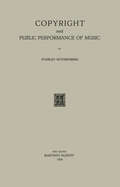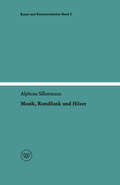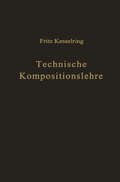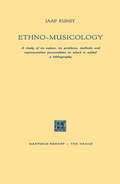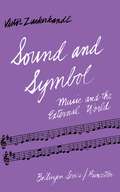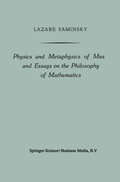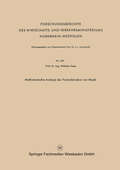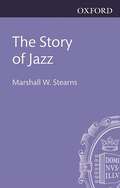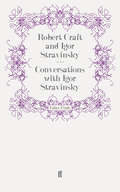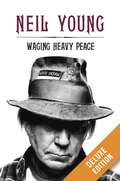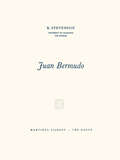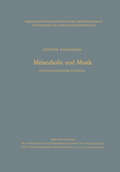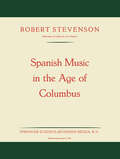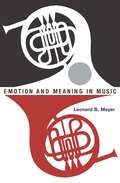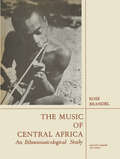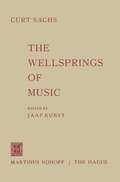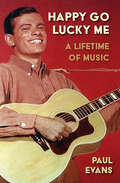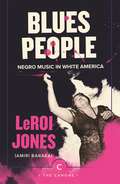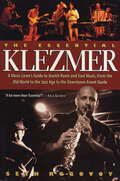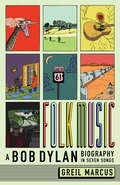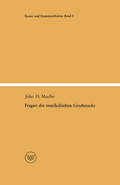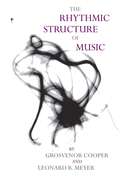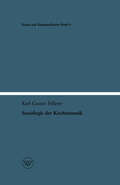- Table View
- List View
Copyright and Public Performance of Music
by Stanley RothenbergThere have been many notable descriptions of music but perhaps one of the most apt from the viewpoint of law and commerce was Ian Hay's statement, "Music is about the most vulnerable piece of property that a man can bring into the world, especially today. " With the increased use of music brought about by technological advances, such as radio, sound films and tele vision, and the concomitant decrease in the sale of sheet music and phonograph records, the need for writers and publishers of music to share in the revenue from public performances became urgent. With this urgency the author's rights in the public per formance of his music became the subject of much literature and litigation which continues to this day. The purpose of this book is to present a clear picture of this much written and litigated about subject: the au'thor's right in the public performance of his music. In order to do this we must indicate not only the nature of the right but also how it is exer cised for it should be evident that with performances taking place throughout the world and in a multitude of ways, the exercise of the right by an individual author or publisher would present insurmountable problems.
Musik, Rundfunk und Hörer: Die soziologischen Aspekte der Musik am Rundfunk (Kunst und Kommunikation #1)
by Alphons SilbermannMusik und Sprache: Das Werden der abendländischen Musik, dargestellt an der Vertonung der Messe (Verständliche Wissenschaft #50)
by Thrasybulos GeorgiadesTechnische Kompositionslehre: Anleitung zu technisch-wirtschaftlichem und verantwortungsbewußtem Schaffen
by Fritz KesselringEthno-Musicology: A study of its nature, its problems, methods and representative personalities to which is added a bibliography
by Jaap KunstThis booklet hardly needs a preface; the contents, I think, speak for themselves. It contains a short and carefully brought up to date resume of all that I, as a private University Lecturer in Amsterdam, have tried to teach my pupils. It is intended as a general introduction to ethno-musicology, before going on to the study of the forms of separate music-cultures. I sincerely hope that those, who wish to teach themselves and to qualify in this branch of knowledge, will find a satisfactory basis for self tuition in the matter here brought together. Regarding the possibility of a new edition, any critical remarks or infor mation as to possible desiderata would be very gratefully received. J.K. PREFACE TO THE SECOND EDITION My request for critical remarks and desiderata has not been ignored. My sincere thanks to all who took the trouble to let me know what they missed in my booklet. Through their collaboration the contents have undergone a considerable improvement and enlargement as compared to the original edition issued in 1950 by the Royal Tropical Institute, Amsterdam, under the title 'Musicologica'. I have taken care to add many particulars from non-European sources, with the result that now the book is no longer so Europe-centric as it was.
Sound and Symbol, Volume 1: Music and the External World (Bollingen Series (General) #655)
by Victor ZuckerkandlAn approach to music as an instrument of philosophical inquiry, seeking not so much a philosophy of music as a philosophy through music.
Mathematische Analyse der Formalstruktur von Musik (Forschungsberichte des Wirtschafts- und Verkehrsministeriums Nordrhein-Westfalen #357)
by Wilhelm FucksThe Story of Jazz
by Marshall W. StearnsThe effect of jazz upon American culture and the American character has been all-pervasive. This superlative history is the first and the most renowned systematic outline of the evolution of this unique American musical phenomenon. Stearns begins with the joining of the African Negro's musical heritage with European forms and the birth of jazz in New Orleans then follows its course through the era of swing and bop to the beginnings of rock in the 50s, vividly depicting the great innovators, and covering such technical elements as the music's form and structure.
Conversations with Igor Stravinsky
by Robert CraftConversations with Igor Stravinsky is the first of the celebrated series of conversation books in which Stravinsky, prompted by Robert Craft, reviewed his long and remarkable life. The composer brings the Imperial Russia of his childhood vividly into focus, at the same time scanning what were at the time the brave new horizons of Boulez and Stockhausen with extraordinary acuity.Stravinsky answers searching questions about his musical development and recalls his association with Diaghilev and the Russian Ballet. There are sympathetic and extraordinarily illuminating reminiscences of such composers as Debussy and Ravel ('the only musicians who immediately understood Le Sacre du Printemps'), while mischievous squibs are directed at others, most notably perhaps against Richard Strauss, all of whose operas Stravinsky wished 'to admit ... to whichever purgatory punishes triumphant banality'.The conversations are by no means confined to musical subjects, ranging uninhibitedly across all the arts: Stravinsky gives unforgettable sketches of Ibsen, Rodin, Proust, Giacometti, Dylan Thomas and T S Eliot.'The conversations between Igor Stravinsky and Robert Craft are unique in musical history. The penetration of Craft's questions and the patience and detail of Stravinsky's answers combine to produce an intimate picture of a man who has sometimes puzzled, often delighted, and always intrigued ...' The Sunday Times
Waging Heavy Peace Deluxe: A Hippie Dream
by Neil YoungThe deluxe eBook edition of Waging Heavy Peace includes excerpts of more than fifteen Neil Young songs (personally selected by Young himself) such as "After the Gold Rush," "Like a Hurricane," and "The Needle and the Damage Done," providing a soundtrack to his stories. Interspersed throughout the text are ten rare Young videos from his own archives, offering an uncommon behind the scenes glimpse of the man behind this memoir. In addition, a complete discography guarantees that diehard devotees and new fans alike enjoy the ultimate Neil Young experience. For the first time, legendary singer, songwriter, and guitarist Neil Young offers a kaleidoscopic view of his personal life and musical creativity. He tells of his childhood in Ontario, where his father instilled in him a love for the written word; his first brush with mortality when he contracted polio at the age of five; struggling to pay rent during his early days with the Squires; traveling the Canadian prairies in Mort, his 1948 Buick hearse; performing in a remote town as a polar bear prowled beneath the floorboards; leaving Canada on a whim in 1966 to pursue his musical dreams in the pot-filled boulevards and communal canyons of Los Angeles; the brief but influential life of Buffalo Springfield, which formed almost immediately after his arrival in California. He recounts their rapid rise to fame and ultimate break-up; going solo and overcoming his fear of singing alone; forming Crazy Horse and writing "Cinnamon Girl," "Cowgirl in the Sand," and "Down by the River" in one day while sick with the flu; joining Crosby, Stills & Nash, recording the landmark CSNY album, Déjà vu, and writing the song, "Ohio;" life at his secluded ranch in the redwoods of Northern California and the pot-filled jam sessions there; falling in love with his wife, Pegi, and the birth of his three children; and finally, finding the contemplative paradise of Hawaii. Astoundingly candid, witty, and as uncompromising and true as his music, Waging Heavy Peace is Neil Young's journey as only he can tell it.
Juan Bermudo
by R. StevensonBERMUDO alone of the many Spanish theorists and composers of the 16th century seems to have written anything specifically for New World use. All the more fitting is it, then, to have completed this monograph in a part of the Spanish Indies that was stirring every Andalusian's imagination during the days when he was first sending his books across the Atlantic. In every way his was a remarkable personality. He was the first to compose and publish any organ music in Spain. As if the publication of such music in staff-notation were not enough he also published the first Spanish keyboard piece in tablature. He was the first in Spain to print any music in score. He is cited by Pincherle as the first to publish a harp method anywhere. He pioneered with the first treatise specifically designed for female use. He also "enjoys" the distinction of having become in Tapia's Verge! de Musica (1570) the most ruthlessly plagiarized writer in Spanish musical history. If bulk determines preeminence he stands above even Tomas de Santa Maria - who published only one volume, and that containing considerably less text. If range of interests determines rank no one else writing in Spanish during his century even approaches him. Nor does anyone else in Spanish have so many authorities at his fingertips.
Melancholie und Musik: Ikonographische Studien (Abhandlungen der Nordrhein-Westfälischen Akademie der Wissenschaften #12)
by Günter BandmannDen Anlaß zu den vorliegenden Studien gab Dürers Kupferstich "Melen colia I" von 1514. Der in dem bewundernswerten Buche von ErwinPanofsky und Fritz Saxl (Dürers "Melencolia I", Leipzig 1923) vorgeführte Bilder kreis, der Vorstufen und Nachwirkungen des Dürerblattes umschreibt, bringt einige Darstellungen - so das Cranachbild von 1533 und die Inletabilitas Radierung von Castiglione -, auf denen sich der Begriff oder die Gestalt der Melancholie mit musikalischen Erscheinungen verbindet. Diesen Bildern las sen sich verwandte Beispiele aus den verschiedensten Epochen und Zusammen hängen zufügen. Die Darstellungen sind nach fünf Gruppen geordnet, in denen Melancholie und Musik je nach den geschichtlichen Umständen verschieden bewertet wer den. Diese Einteilung der Kapitel ist grob. Die Plurivalenz der Melancholie und der Musik bringt es mit sich, daß in vielen Darstellungen verschiedene Bedeutungen mitschwingen und das gleiche Denkmal eigentlich verschiedenen Rubriken zugeordnet werden könnte. In der Miniatur aus dem Stuttgart Psalter (Tafel 2, S. 25) ist Melancholie nicht nur Leiden, sondern auch Ge mütsverfassung, die den Menschen in ein besonderes Verhältnis zu Gott bringt, auch auf der indischen Miniatur (Tafel 3, S. 49) scheint sich die Melancholie in eine positiv empfundene Stimmung zu wenden; auf der Castiglione-Radierung (Abb. 47) ist die Musik sowohl verworfenes weltliches Treiben als auch Hilfe zur Divination. Affekte und sinnliche Erfahrungen des Menschen sind selbst in statisch geordneten Weltvorstellungen abhängig von den Konstellationen und Umständen ihrer Begegnung.
Emotion and Meaning in Music
by Leonard B. Meyer"Altogether it is a book that should be required reading for any student of music, be he composer, performer, or theorist. It clears the air of many confused notions . . . and lays the groundwork for exhaustive study of the basic problem of music theory and aesthetics, the relationship between pattern and meaning."—David Kraehenbuehl, Journal of Music Theory "This is the best study of its kind to have come to the attention of this reviewer."—Jules Wolffers, The Christian Science Monitor "It is not too much to say that his approach provides a basis for the meaningful discussion of emotion and meaning in all art."—David P. McAllester, American Anthropologist "A book which should be read by all who want deeper insights into music listening, performing, and composing."—Marcus G. Raskin, Chicago Review
Emotion and Meaning in Music
by Leonard B. Meyer"Altogether it is a book that should be required reading for any student of music, be he composer, performer, or theorist. It clears the air of many confused notions . . . and lays the groundwork for exhaustive study of the basic problem of music theory and aesthetics, the relationship between pattern and meaning."—David Kraehenbuehl, Journal of Music Theory "This is the best study of its kind to have come to the attention of this reviewer."—Jules Wolffers, The Christian Science Monitor "It is not too much to say that his approach provides a basis for the meaningful discussion of emotion and meaning in all art."—David P. McAllester, American Anthropologist "A book which should be read by all who want deeper insights into music listening, performing, and composing."—Marcus G. Raskin, Chicago Review
The Music of Central Africa: An Ethnomusicological Study Former French Equatorial Africa the Former Belgian Congo, Ruanda-Urundi Uganda, Tanganyika
by Rose BrandelUnder the inspiring guidance of my mentor, Curt Sachs, this work was conceived, planned, and executed. It gained in dimension under the acute and patient perusal of Gustave Reese to whose brilliant propensity for clarity of thought and of style I owe a huge debt. Furthermore, the helpful suggestions made by Martin Bernstein and by J an LaRue are gratefully acknowledged. If Jaap Kunst had not kindly gone to the trouble of ordering, supervising the con struction of, and mailing to me from Amsterdam his personally designed monochord, an important section of this work could not have taken form. This preface is not complete, of course, without final thanks to my husband, Harvey B. Natanson, for his sustained interest and encouragement. R. B. Note As the present work goes to press, the political map of Africa is flowing into a new mold. Several countries have obtained independence, and new names and data should be con sidered: French Equatorial Africa has become (November 28-December I, 1958) four independent countries - Republic of the Congo: Brazzaville (formerly Middle Congo), Gabon Republic (formerly Gabon) , Central African Republic (formerly Ubangi-Shari), and Republic of Chad (formerly Chad). The Belgian Congo has become (June 30,1960) the Republic of the Congo: Leopoldville.
Happy Go Lucky Me: A Lifetime of Music
by Paul EvansPaul Evans, a New Yorker has had a long and varied musical career. As a songwriter, Paul has written hits for himself as well as for Bobby Vinton – the 1962 classic, ‘Roses Are Red, My Love’, the Kalin Twins ‘When’ in 1957, and Elvis Presley ‘The Next Step is Love’ and ‘I Gotta Know’ and more. His songs have been featured in movies – Martin Scorsese’s Goodfellas and John Waters’ Pecker, television shows (Scrubs) and TV ads. He also wrote an off-off Broadway show, Cloverleaf Crisis, and the theme for the original network television show, CBS This Morning. Paul has spent a great deal of his life as a recording artist. From his 1959 and 60’s hits: ‘Seven Little Girls Sitting in The Back Seat’, ‘Midnight Special’ and ‘Happy Go Lucky Me’ to his 1979 hit: ‘Hello, This Is Joannie’, #6 on the UK pop charts and Top 40 on Billboard’s Country charts. This book describes his journey from getting his start in the music business, becoming part of the Brill’s song-writing community and the sixty-three music-filled years that followed.
Blues People (Canons)
by LeRoi JonesIn this essential and impassioned text, LeRoi Jones traces the intertwined development of blues and jazz music with the history of its creators in ‘White America’. As important and relevant as at its first publication in 1963, it shows how music and its people are inseparable – expressing and reflecting the other, surviving and adapting through oppression.
The Essential Klezmer
by Seth RogovoyYou can hear it in the hottest clubs in New York, the hippest rooms in New Orleans, Chicago, and San Francisco, and in top concert halls around the world. It's a joyous sound that echoes the past. It's Old World meets New World. It's secular and sacred. It's traditional and experimental. It's played by classical violinist Itzhak Perlman (his all-klezmer album in his all-time best-seller!), the hypno-pop band Yo La Tengo, and avant-gardist John Zorn. It made the late great Benny Goodman's clarinet wail. It's klezmer and it's hot!The Essential Klezmer is the definitive introduction to a musical form in the midst of a renaissance. It documents the history of klezmer from its roots in the Jewish communities of medieval Eastern Europe to its current revival in Europe and America. It includes detailed information about the music's social, cultural, and political roots as well as vivid descriptions of the instruments, their unique sounds, and the players who've kept those sounds alive through the ages. Music journalist Seth Rogovoy skillfully conveys the emotional intensity and uplifting power of klezmer and the reasons for its ever widening popularity among Jews and Gentiles, Hasidim and club kids, grandparents and their grandkids. A comprehensive discography presents the "Essential Klezmer Library," extensive lists of recordings, artists, and styles, as well as an up-to-the-minute resource of music retailers, festivals, workshops, and klezmer Web sites.The Essential Klezmer is as entertaining as it is enlightening.
Folk Music: A Bob Dylan Biography in Seven Songs
by Greil MarcusAcclaimed cultural critic Greil Marcus tells the story of Bob Dylan through the lens of seven penetrating songs “Marcus delivers yet another essential work of music journalism.”—Kirkus Reviews (starred review) “Further elevates Marcus to what he has always been: a supreme artist-critic.”—Hilton Als “Greil Marcus is already the most important chronicler of Dylan. But here he outdoes himself.”—Rachel Kushner Across seven decades, Bob Dylan has been the first singer of American song. As a writer and performer, he has rewritten the national songbook in a way that comes from his own vision and yet can feel as if it belongs to anyone who might listen. In Folk Music, Greil Marcus tells Dylan’s story through seven of his most transformative songs. Marcus’s point of departure is Dylan’s ability to “see myself in others.” Like Dylan’s songs, this book is a work of implicit patriotism and creative skepticism. It illuminates Dylan’s continuing presence and relevance through his empathy—his imaginative identification with other people. This is not only a deeply felt telling of the life and times of Bob Dylan, but a rich history of American folk songs and the new life they were given as Dylan sat down to write his own.
Fragen des musikalischen Geschmacks: Eine musiksoziologische Studie (Kunst und Kommunikation #8)
by John Henry MuellerThe Rhythmic Structure of Music
by Grosvenor Cooper Leonard B. MeyerIn this influential book on the subject of rhythm, the authors develop a theoretical framework based essentially on a Gestalt approach, viewing rhythmic experience in terms of pattern perception or groupings. Musical examples of increasing complexity are used to provide training in the analysis, performance, and writing of rhythm, with exercises for the student's own work. "This is a path-breaking work, important alike to music students and teachers, but it will make profitable reading for performers, too."—New York Times Book Review "When at some future time theories of rhythm . . . are . . . as well understood, and as much discussed as theories of harmony and counterpoint . . . they will rest in no small measure on the foundations laid by Cooper and Meyer in this provocative dissertation on the rhythmic structure of music."—Notes ". . . . a significant, courageous and, on the whole, successful attempt to deal with a very controversial and neglected subject. Certainly no one who takes the time to read it will emerge from the experience unchanged or unmoved."—Journal of Music Theory The late GROSVENOR W. COOPER, author of Learning to Listen, was professor of music at the University of California at Santa Cruz.
